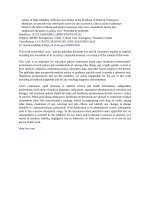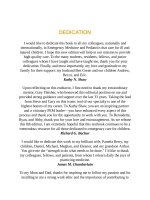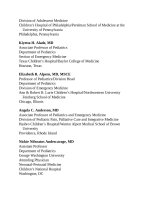Pediatric emergency medicine trisk 628
Bạn đang xem bản rút gọn của tài liệu. Xem và tải ngay bản đầy đủ của tài liệu tại đây (180.29 KB, 4 trang )
Neonatal facial nerve palsy arises either from a traumatic birth injury or from
hereditary agenesis of the facial nerve nucleus (Moebius syndrome). Traumatic
peripheral nerve injury takes place when the facial nerve is compressed as it exits
the stylomastoid foramen or branches within the ramus of the mandible.
Compression of the facial nerve may occur during pregnancy or during delivery
and may occur as a result of oblique midforceps application, or pressure on the
face by extreme prolonged pressure by the sacrum, other fetal parts or uterine
fibroid tumors. Peripheral injury is unilateral and may be associated with brachial
nerve palsy. Traumatic central nerve injury results from destruction of
contralateral brain tissue within the posterior fossa or the temporal bone.
Traumatic central injury is rare and can affect other cranial nerves.
Neonates with peripheral facial nerve injury will display injury to both the
upper and lower face on the ipsilateral side within the first few days. Typically
the forehead is smooth with inability to close the eye, and there is a smooth
nasolabial fold and drooping at the corner of the mouth on the paralyzed
ipsilateral side. When the baby cries the contralateral corner of the mouth will
move. Since other cranial nerves are intact the baby will have no trouble feeding.
Peripheral facial nerve palsy starts to recover within days, with complete
resolution within weeks to months. Initial supportive care includes corneal
protection with petroleum ointment, and eye pad during periods of sleep, or 1%
methyl cellulose eye drops every 4 hours. Neonates should be further referred for
neurologic evaluation and electrodiagnostic testing to ensure recovery is
monitored appropriately. Infants who show poor recovery at 1 year of age may be
candidates for surgical intervention.
FIGURE 96.26 Noncontrast CT scan showing left-sided subgaleal and subdural hemorrhages
in a newborn. Axial noncontrast CT images show subdural hemorrhage along the left leaf of the
tentorium (large white arrow ), in the interhemispheric fissure near the falcotentorial junction
(small white arrow ), along the left cerebral convexity subdural space, and in the subcutaneous
and subgaleal spaces. Note the severity of the cerebral cortical involvement. (Reprinted with
permission from Barkovich J, Raybaud C. Pediatric Neuroimaging . 5th ed. Philadelphia, PA:
Lippincott Williams & Wilkins; 2011.)
Moebius Syndrome
Moebius syndrome is a hereditary absence of the VI and VII nerve nuclei. This
results in loss of use of facial muscles and lateral eye motion. Infants are unable
to move facial muscles so that the face remains expressionless and immobile. The
condition is associated with micrognathia, microstomia, muscle weakness,
recurrent aspiration, earlobe deformities, and thoracic and limb deformities. There
may be notable dryness of the eyes due to lack of inability to close the eyelids.
Neonates with this condition may have difficulty feeding and require respiratory
support due to aspiration. Therapy consists of ongoing supportive care. Many
newborns are unable to breast-feed or feed from a regular nipple. Infants may
require feeding tubes or a Haberman nipple to obtain adequate nutritional intake.
Facial Asymmetry
Facial asymmetry occurs in a newborn because of abnormal in utero position.
Commonly, when the face and neck are pressed against the shoulder, a
characteristic flattening of the face and angle of the jaw is noted on that side
because of displacement of the mandible. This facial asymmetry will resolve
spontaneously in a few weeks.
Congenital Torticollis
Congenital muscular torticollis is a positional abnormality of the neck, resulting
in abnormal tilting and rotation of the head. It is believed to be secondary to
intrauterine positioning or trauma to the soft tissues of the neck during delivery,
with resulting ischemia of the sternocleidomastoid muscle. This leads to edema
and degeneration of the muscle fibers with eventual fibrosis of the muscle body.
Although congenital muscular torticollis may be noted at birth, it usually
manifests at 1 to 2 weeks of age. The incidence is increased in breech
presentations and difficult deliveries. Unilateral contracture and fibrosis of the
sternocleidomastoid muscle results in a mass and a characteristic head tilt toward
the affected side and the chin pointing toward the opposite side ( Fig. 96.27 ).
This position is fixed and does not correct with passive attempts to move the
head. On examination, a firm, nontender mass may be felt within the body of the
sternocleidomastoid muscle which then enlarges within the following 1 to 2
weeks. The baby may develop plagiocephaly in the long term if left untreated.
Occipitocervical spine anomalies, such as the Klippel–Feil syndrome (congenital
fusion of two or more cervical vertebrae; clinical triad of short neck, limited neck
motion, and low occipital hairline), are rare causes of torticollis that present in the
newborn period. Spinal and neck x-ray may help in differentiating between these
cervical spine anomalies and congenital torticollis. Similarly, ultrasound or CT
scan of the neck or soft tissue MRI will help differentiate other soft tissue masses
that may have a similar appearance (e.g., hemangioma). Treatment consists of
passive stretching exercises of the neck and repositioning toys and mobiles in the
crib to stimulate the infant to look toward the side opposite the preferred gaze.
Positioning and referral for physiotherapy is recommended as early as possible.
Surgery may be considered if there is no response to conservative management.
Prognosis improves if the baby is treated before 1 year of age.
FIGURE 96.27 Congenital torticollis. A fibrotic mass located in the sternocleidomastoid
muscle of a 1-month-old infant whose mother was concerned about the infant’s head tilt to one
side. (From Courtesy of Ellen Deutsch. In: Chung EK, Atkinson-McEvoy LR, Boom JA, et al.,
eds. Visual Diagnosis and Treatment in Pediatrics . 2nd ed. Philadelphia, PA: Lippincott
Williams & Wilkins; 2010. With permission.)
Neonatal Eye Disorders
Goals of Treatment
Neonatal eye disorders are infrequent. They, however, do have the potential of
causing serious harm if missed. The most challenging part of the eye examination
is actually opening the eye of a newborn since any attempt at forcing them open
usually meets with marked resistance and blepharospasm. Darkening the
examination room, holding the baby upright and gently swaying him or her from
side to side or up and down often induces the eyes to open spontaneously.
Neonatal ophthalmologic concerns include leukocoria, neonatal conjunctivitis,
excessive tearing, scleral and subconjunctival hemorrhages, and uncoordinated
eye movements. Absence of red reflex or presence of leukocoria could indicate
the presence of retinoblastoma. Cataracts that are not treated may affect visual
acuity or lead to visual loss. Physicians need to focus on diagnosis of subtle
findings early in their course. Once issues such as absence of red reflex are
identified prompt ophthalmology referral is needed.









